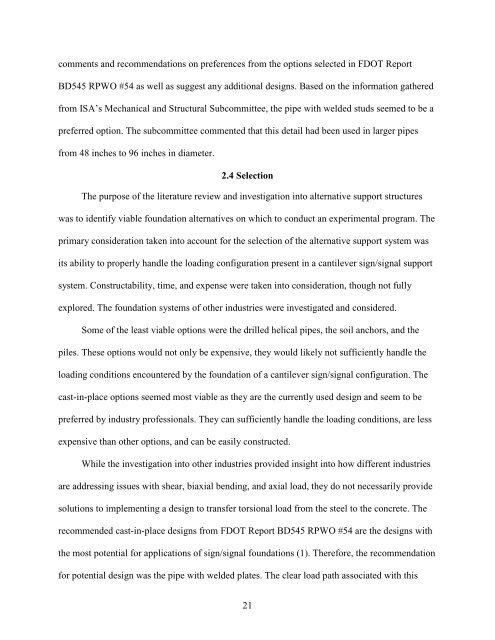Alternative Support Systems for Cantilever - National Transportation ...
Alternative Support Systems for Cantilever - National Transportation ...
Alternative Support Systems for Cantilever - National Transportation ...
Create successful ePaper yourself
Turn your PDF publications into a flip-book with our unique Google optimized e-Paper software.
comments and recommendations on preferences from the options selected in FDOT Report<br />
BD545 RPWO #54 as well as suggest any additional designs. Based on the in<strong>for</strong>mation gathered<br />
from ISA’s Mechanical and Structural Subcommittee, the pipe with welded studs seemed to be a<br />
preferred option. The subcommittee commented that this detail had been used in larger pipes<br />
from 48 inches to 96 inches in diameter.<br />
2.4 Selection<br />
The purpose of the literature review and investigation into alternative support structures<br />
was to identify viable foundation alternatives on which to conduct an experimental program. The<br />
primary consideration taken into account <strong>for</strong> the selection of the alternative support system was<br />
its ability to properly handle the loading configuration present in a cantilever sign/signal support<br />
system. Constructability, time, and expense were taken into consideration, though not fully<br />
explored. The foundation systems of other industries were investigated and considered.<br />
Some of the least viable options were the drilled helical pipes, the soil anchors, and the<br />
piles. These options would not only be expensive, they would likely not sufficiently handle the<br />
loading conditions encountered by the foundation of a cantilever sign/signal configuration. The<br />
cast-in-place options seemed most viable as they are the currently used design and seem to be<br />
preferred by industry professionals. They can sufficiently handle the loading conditions, are less<br />
expensive than other options, and can be easily constructed.<br />
While the investigation into other industries provided insight into how different industries<br />
are addressing issues with shear, biaxial bending, and axial load, they do not necessarily provide<br />
solutions to implementing a design to transfer torsional load from the steel to the concrete. The<br />
recommended cast-in-place designs from FDOT Report BD545 RPWO #54 are the designs with<br />
the most potential <strong>for</strong> applications of sign/signal foundations (1). There<strong>for</strong>e, the recommendation<br />
<strong>for</strong> potential design was the pipe with welded plates. The clear load path associated with this<br />
21
















